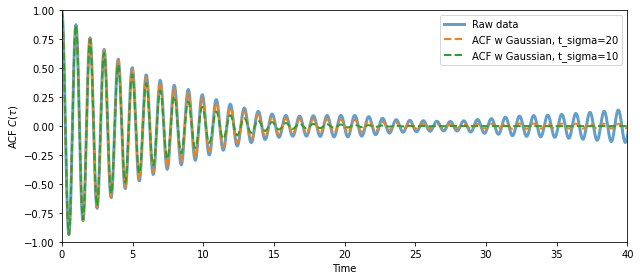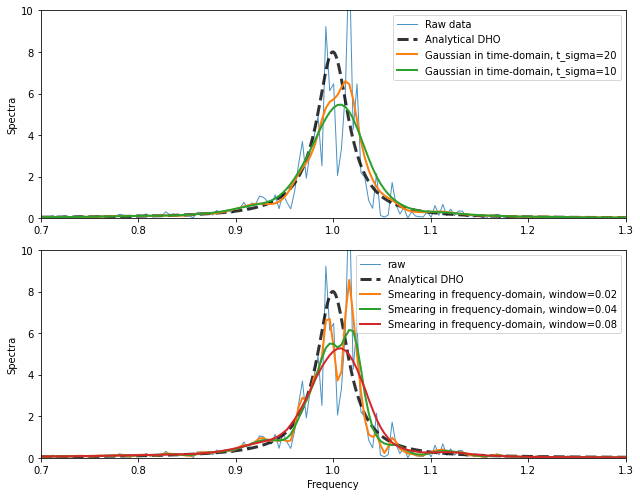Auto correlation functions and FFTs#
This tutorial provides some brief introduciton to auto-correlation functions (ACFs), fourier transforms and numerical tools for obtaining less noisy results.
For a complex time signal \(x(t)\) the corresponding ACF is defined as
and is typically normalized such that \(C(\tau=0)=1\)
Damped harmonic oscillator#
Here, we will consider a basic example where a the time-signal, \(x(t)\), comes from a damped harmonic oscillator (DHO). We use a natrual frequency of the oscillator \(f_0=1.0\) (\(\omega_0 = 2 \pi\)) and damping \(\Gamma=0.25\) (lifetime \(\tau=8\)).
[1]:
import numpy as np
import matplotlib.pyplot as plt
[2]:
# DHO parameters
dt = 0.05
f0 = 1.0
w0 = np.pi * 2 * f0
gamma = 0.25
# read signal data and make up time array
signal = np.loadtxt('signal.txt')
time = np.arange(0, len(signal), dt)
print('signal shape', signal.shape)
signal shape (29999,)
Signal in time#
Inspect a part of the signal in time.
[3]:
t_max = 1000
t_lim = [0, t_max * dt]
fig = plt.figure(figsize=(9, 4))
plt.plot(time[:t_max], signal[:t_max])
plt.xlim(t_lim)
plt.xlabel('Time')
plt.ylabel('Signal');

Autocorrelation function#
Here, we compare the calculated ACF with the analytical known solution for a DHO. For longer time-scales we see the agreement become worse and worse due to the limited size of our time-signal (i.e. poor statistics).
[4]:
from dynasor.tools.acfs import compute_acf
from dynasor.tools.damped_harmonic_oscillator import acf_position_dho
t_acf, acf_raw = compute_acf(signal, delta_t=dt)
acf_analytical = acf_position_dho(t_acf, w0, gamma)
fig = plt.figure(figsize=(9, 4))
plt.plot(t_acf, acf_raw, lw=3.0, alpha=0.7, label='Raw data')
plt.plot(t_acf, acf_analytical, '--', label='Analytical DHO')
plt.legend(loc=1)
plt.xlim(t_lim)
plt.ylim([-1, 1])
plt.xlabel('Time')
plt.ylabel(r'ACF $C(\tau)$');

Decay functions (smearing/smoothing)#
The ACF above oscillates during the first 50 timesteps, and then decays towards zero after about 100 timesteps. However, the ACF continous to oscillate even for longer times due to noise and insufficent sampling of the ACF.
dynasor provides some utility functions for these things, for example a gaussian decay function (gaussian_decay) and a Fermi-Dirac like decay function (fermi_dirac).[5]:
from dynasor.tools.acfs import fermi_dirac, gaussian_decay
t_decay = 15
decay_fermi = fermi_dirac(t_acf, t_0=1.4*t_decay, t_width=t_decay/5)
decay_gauss = gaussian_decay(t_acf, t_sigma=t_decay)
fig = plt.figure(figsize=(9, 4))
plt.plot(t_acf, decay_fermi, label='Fermi-Dirac')
plt.plot(t_acf, decay_gauss, label='Gaussian')
plt.legend(loc=1)
plt.xlim(t_lim)
plt.xlabel('Time')
plt.ylabel('Smearing function');

For simiplicity in this tutorial we will stick to using a Gaussian decay function, \(f(t)\), defined as \begin{equation} f(t) = \exp{\left [-\frac{1}{2} \left (\frac{t}{t_\mathrm{sigma}}\right )^2 \right ] } \end{equation} where the parameter \(t_\mathrm{sigma}\) is the “decay-time” of function.
[6]:
# construct ACFs with decay functions applied
decay_times = [20, 10]
acf_gauss = dict()
for t_sigma in decay_times:
acf_gauss[t_sigma] = acf_raw * gaussian_decay(t_acf, t_sigma=t_sigma)
[7]:
fig = plt.figure(figsize=(9, 4))
ax = fig.add_subplot(111)
plt.plot(t_acf, acf_raw, lw=3.0, alpha=0.7, label='Raw data')
for t_sigma, acf in acf_gauss.items():
ax.plot(t_acf, acf, '--', lw=2.0, label=f'ACF w Gaussian, t_sigma={t_sigma}')
ax.legend(loc=1)
ax.set_xlim([0, 40])
ax.set_ylim([-1, 1])
ax.set_xlabel('Time')
ax.set_ylabel(r'ACF $C(\tau)$')
fig.tight_layout();

Fourier transforms and spectral#
ACFs can be fourier transformed to obtain the spectra of the time signal. Assuming the time-signal is even we can use the fourier_cos_filon as implemented in dynasor.
smoothing_function. The window_size chosen for the smearing in frequency is roughly equivalent to applying a decay function in the time-domain with a decay-time of 1/window_size. There are many different window functions/shapes to chose from, , here we simply employ the default (Hamming)Note one can also zero-pad the ACF (and apply other FFT tricks) to get a nicer looking spectra.
[8]:
from dynasor.post_processing import fourier_cos_filon
from dynasor.tools.acfs import smoothing_function
[9]:
n_max = 4999
# raw FFT
w, S_raw = fourier_cos_filon(np.array([acf_raw[:n_max]]), dt)
f = w / 2 / np.pi
delta_f = f[1] - f[0]
# gaussian ACFs
S_gauss = dict()
for t_sigma, acf in acf_gauss.items():
_, S = fourier_cos_filon(np.array([acf[:n_max]]), dt)
S_gauss[t_sigma] = S
# smearing
S_smear = dict()
for window_size in [5, 10, 20]:
window = window_size * delta_f
S_smear[window] = smoothing_function(S_raw[0], window_size=window_size)
print('window_size in frequency', window)
print('1/window_size in time', 1/window)
window_size in frequency 0.010004001600640256
1/window_size in time 99.96
window_size in frequency 0.020008003201280513
1/window_size in time 49.98
window_size in frequency 0.040016006402561026
1/window_size in time 24.99
[10]:
from dynasor.tools.damped_harmonic_oscillator import psd_position_dho
f_lin = np.linspace(0, 2, 10000)
S_dho = psd_position_dho(f_lin * np.pi * 2, w0, gamma)
fig = plt.figure(figsize=(9, 7))
ax1 = fig.add_subplot(211)
ax2 = fig.add_subplot(212)
ax1.plot(f, S_raw[0], '-', lw=1.0, alpha=0.8, label='Raw data')
ax1.plot(f_lin, S_dho, '--k', lw=3.0, alpha=0.8, label='Analytical DHO')
for t_sigma, S in S_gauss.items():
ax1.plot(f, S[0], '-', lw=2.0, label=f'Gaussian in time-domain, t_sigma={t_sigma}')
ax2.plot(f, S_raw[0], '-', lw=1.0, alpha=0.8, label='raw')
ax2.plot(f_lin, S_dho, '--k', lw=3.0, alpha=0.8, label='Analytical DHO')
for t_sigma, S in S_smear.items():
ax2.plot(f, S, '-', lw=2.0, label=f'Smearing in frequency-domain, window={t_sigma:.2f}')
for ax in [ax1, ax2]:
ax.legend(loc=1)
ax.set_xlim([0.7, 1.3])
ax.set_ylim([0, 10])
ax.set_ylabel('Spectra')
ax2.set_xlabel('Frequency')
fig.tight_layout();

We expect the peak at 1.0 as this is the natrual frequency of the DHO. The width of the peak is the damping \(\Gamma\).
Note here that a too agreesive decay-function in time or smearing function in frequency domain yields and artifically broader peak.
